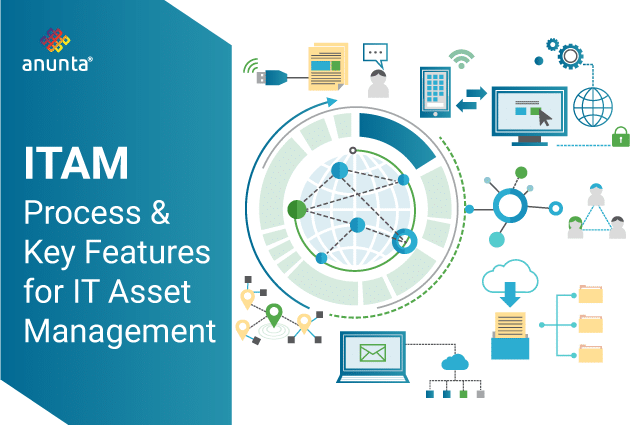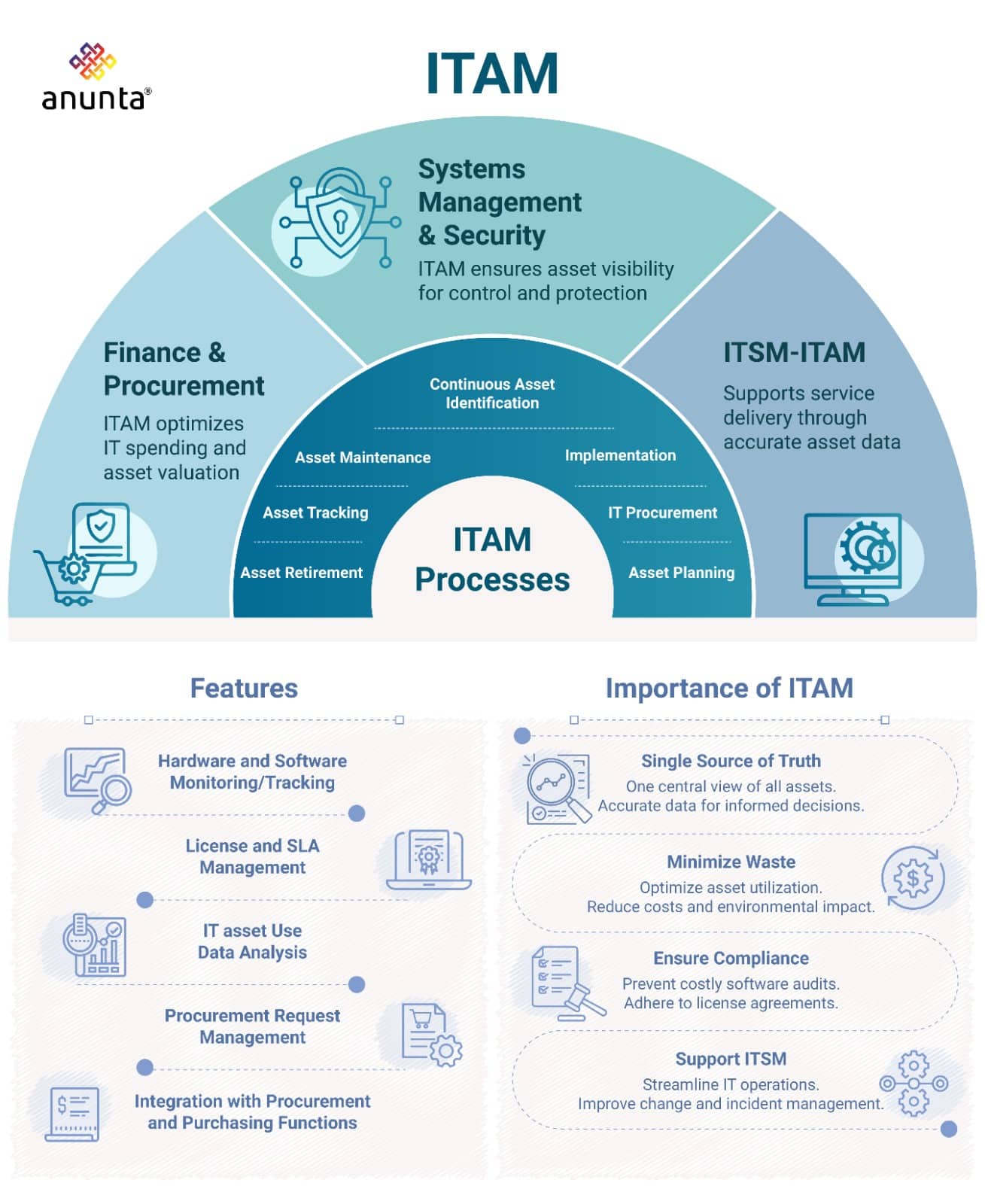
IT asset management is a subset of IT operations management that deals with the acquisition, procurement, monitoring, optimization, maintenance, and retirement of both software and hardware assets. ITAM is a crucial discipline if you want to extend the lifespan of technology resources and use them to their full potential. Cybersecurity, digital transformation, AI adoption, and business growth all hinge on an effective ITAM strategy.
Organization growth leads to requiring more employees, which subsequently demands additional desktops, servers, and larger networks. Thus, Business expansion and IT advancement go hand in hand.
With your business expansion, you need to set up an IT asset management policy. This would enable you to administer your software and hardware resources across their entire lifecycle. The goal is to minimize business interruptions, manage budgets, eliminate risks, and acquire an overview of how IT influences business outcomes.
ITAM, is the practice of accounting for deploying, maintaining, upgrading, and/or discarding the organization’s technology assets. It strives to maximize the value of IT machinery within an organization by integrating financial, contractual, and inventory data to monitor the status of IT assets. Typically, IT assets can be classified as either hardware or software.
An information technology (IT) resource is any data, software, or hardware an organization uses to run its business. It can be of two types:
Hardware Assets: A hardware asset is a tangible, physical company technology asset. It includes computer equipment, communication equipment, data storage media, and other technical equipment supporting the functioning of the information system.
ITAM monitors hardware ownership, usage, maintenance status, and renewal or disposal timeframes.
Software Assets: A software asset is a type of asset that includes applications, systems, databases, and cloud-based services. They are typically licensed per user or machine or built using open-source resources. These can be considered long-term or fixed assets if they are used over an extended period and are not purchased with the intent of resale.
IT asset management allows organizations to monitor the current state of software licensing agreements, prepare for future licensing payments, and manage the number of active licenses. This ensures they receive the greatest value from every software license purchased.
These assets have a limited lifespan. IT asset lifecycles can be proactively managed to maximize their value. Each organization may define the phases of this lifecycle differently; however, it usually involves planning, purchasing, implementation, and upkeep.
The application of processes across all lifecycle phases to figure out the total cost of ownership and optimize asset utilization is an essential component of IT asset management.
A typical IT asset management workflow involves the following steps:

This involves determining the organization’s need for IT assets, their intended use, and how to obtain them. Organizations also consider competitive solutions and carry out cost-benefit or total cost of ownership (TCO) assessments of all potential options during this Asset planning and acquisitions.
The IT procurement process involves defining IT requirements, managing vendors, negotiating and implementing contracts, existing asset management, and verifying the quality of products and services provided1. A nine-step IT procurement process includes:
Asset implementation phase contains deployment of an asset can involve setup, incorporation with other tools, user access, and technical assistance. A company can partner with an external systems integrator (SI) to complete this step.
This generates a comprehensive list of all IT assets. It facilitates simple identification and optimizes redundant assets for greater efficiency. The identification process runs continuously to discover any new asset the organization acquires.
IT assets are regularly monitored by ITAM tools. Data collected for asset monitoring consists of the following:
The maintenance of IT assets depends on their lifecycle stage. Upkeep includes repair, upgrades, and replacement of assets. As part of the ITAM process, all maintenance activities are documented so that the information can be used to evaluate performance. This will increase their lifespan, decrease costs, and mitigate hazards.
When the frequency of maintenance increases, an IT asset hits the endpoint of its lifecycle. At this point, the organization would be investing more in it than the asset generates in value. A company might also decide to let go of an asset if superior alternatives are available. Retiring assets include disposal, asset data updates, support termination, and license agreements. Importantly, it also involves planning the transition to new assets.
IT asset management is an area of expertise founded on accumulating and evaluating data. While these used to be paper records and then spreadsheets or tables, modern ITAM systems enable many useful features and capabilities.
An integrated data monitoring solution is essential to IT asset management. The inventory monitoring feature of ITAM programs stretches beyond a basic catalog of readily accessible assets. It consists of specific hardware and software standards for improved decision-making. This feature enables visibility into details such as the asset’s date of purchase, CPU and GPU speed, memory, available disk space, network IP address, and other parameters.
As part of tracking, most IT asset management systems instantly identify all hardware and software stationed within a company’s computer network.
ITAM software maintains licenses for IT assets. These are then cross-referenced against the appropriate inventory data. As such, ITAM notifies the company if an asset is unlicensed, in danger of violating a license agreement, or is over-licensed (procuring software that it under-uses or never uses). The system can also monitor license agreement expiration dates and alert the company accordingly.
ITAM can help evaluate software installations and analyze software usage numbers. This aids in reducing the expenses associated with inactive software licenses. For example, using data analytics dashboards, ITAM would notify you if your organization has purchased 15 licenses but only runs the application ten times. This would reveal any cost savings possibilities that are available to the organization.
A few ITAM software allow businesses to establish asset request workflows and monitor every request for an IT asset. They assess these assets’ license prerequisites and supervise their purchase and implementation.
Several organizations monitor IT purchases via a procurement system and IT inventory via another system, and a link between these two platforms can often be missing. Integrating the two is fast becoming a common feature with modern ITAM. This enables organizations to precisely evaluate their inventory and predict future requirements through the same interface.
IT asset administrators can plan new purchases based on equipment that is nearing the close of its shelf life. They can analyze financial data in conjunction with IT inventory utilization data to figure out the best strategy for the disposal of assets.
Optionally, ITAM includes features to manage digital assets. This digital asset management (DAM) capability is necessary to administer digital rights and rich media (multimedia content such as videos, audio, and images/photographs).
Historically, IT departments could manage the assets that resided within their area of expertise. Nowadays, the asset management practices of companies extend well beyond this ambit to equipment and software that do not carry any official IT authorization.
Asset management challenges also arise from subscription-based software or staff requests for tool customization. As other teams or divisions embrace cutting-edge technologies, asset management becomes vital for an increasing number of departments. Organizations can use ITAM software to manage anything from car leases to insurance policies.
ITAM is a crucial discipline for organizations because it:
Managing assets monitored in multiple locations is difficult. A pattern of inaccuracy and disorder could lead to inefficiencies and flawed decision-making. ITAM enables organizations to assess everything that needs to be monitored in one centralized location. This includes the assets that must be disposed of, upgraded, or optimized for maximum productivity.
By adopting an ITAM process, an organization acquires real-time data on the condition of all its assets and can make informed decisions on asset utilization. Consequently, teams would minimize waste and boost efficiency. It also saves resources by avoiding needless purchases and reducing licensing or support expenses.
Companies that lease third-party software are often subject to software audits. This ensures conformity with the license terms and conditions. Failure to comply with the contracts could result in hefty penalties. ITAM ensures adherence to applicable license agreements to avoid such losses.
IT asset management is essential to enable IT service management (ITSM) processes such as change and incident management. With the right data, teams can move quickly and foresee the impacts of changes well in advance.
Organizations looking to maximize IT investments, reduce risks, and spur business expansion must prioritize IT asset management, or ITAM. Businesses can achieve considerable cost savings, improve operational efficiency, and make better decisions by managing the asset lifecycle—from purchase to disposal—effectively. To maximize its impact and guarantee alignment with overarching business objectives, ITAM must be integrated with other crucial IT operations. The ability to fully utilize IT resources and obtain a competitive advantage in the current digital environment is ultimately provided by a strong ITAM strategy.